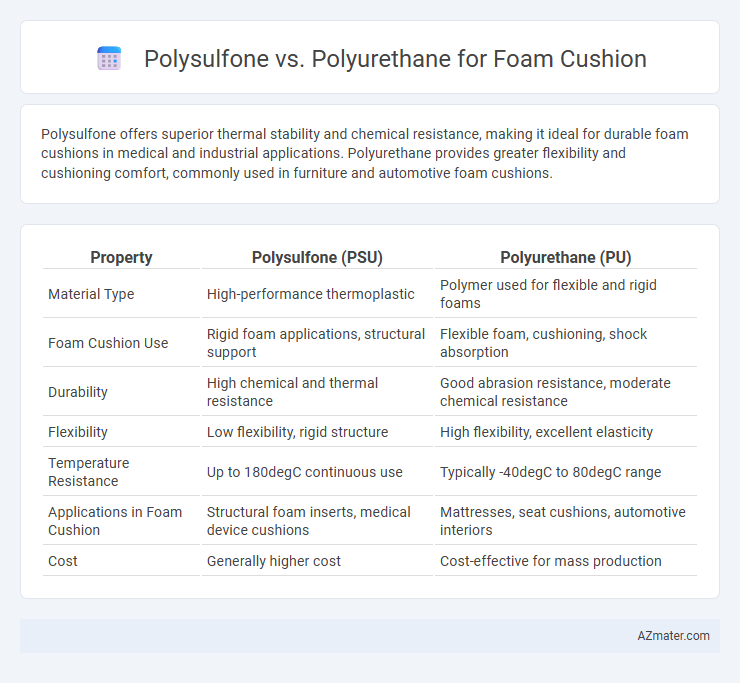Polysulfone offers superior thermal stability and chemical resistance, making it ideal for durable foam cushions in medical and industrial applications. Polyurethane provides greater flexibility and cushioning comfort, commonly used in furniture and automotive foam cushions.
Table of Comparison
| Property | Polysulfone (PSU) | Polyurethane (PU) |
|---|---|---|
| Material Type | High-performance thermoplastic | Polymer used for flexible and rigid foams |
| Foam Cushion Use | Rigid foam applications, structural support | Flexible foam, cushioning, shock absorption |
| Durability | High chemical and thermal resistance | Good abrasion resistance, moderate chemical resistance |
| Flexibility | Low flexibility, rigid structure | High flexibility, excellent elasticity |
| Temperature Resistance | Up to 180degC continuous use | Typically -40degC to 80degC range |
| Applications in Foam Cushion | Structural foam inserts, medical device cushions | Mattresses, seat cushions, automotive interiors |
| Cost | Generally higher cost | Cost-effective for mass production |
Introduction to Foam Cushion Materials
Polysulfone and polyurethane are two prominent materials used in foam cushions, each offering distinct chemical properties and performance characteristics. Polysulfone provides exceptional thermal stability and chemical resistance, making it suitable for high-performance cushioning applications, while polyurethane is renowned for its flexibility, resilience, and cost-effectiveness in everyday foam cushion production. Understanding the molecular structure and durability differences between polysulfone and polyurethane is essential for selecting the optimal foam cushion material tailored to specific comfort and longevity requirements.
What is Polysulfone Foam?
Polysulfone foam is a high-performance thermoplastic known for its excellent mechanical strength, thermal stability, and chemical resistance, making it suitable for foam cushioning applications requiring durability and longevity. Its closed-cell structure provides superior insulation and resistance to moisture absorption compared to polyurethane foam, which is more flexible but less resistant to heat and chemicals. In foam cushions, polysulfone offers enhanced structural support and maintains shape under stress, ideal for specialized industrial and medical uses.
What is Polyurethane Foam?
Polyurethane foam is a versatile polymer widely used for foam cushions due to its excellent cushioning, durability, and flexibility. It is formed by reacting polyols and diisocyanates, creating a cellular structure that provides softness and support in various applications. Compared to polysulfone, polyurethane foam offers superior comfort and adaptability for seating and bedding products.
Physical Properties Comparison
Polysulfone foam cushions exhibit superior thermal stability and mechanical strength compared to polyurethane, maintaining durability at temperatures up to 190degC, whereas polyurethane foams typically degrade above 120degC. Polysulfone offers higher rigidity and excellent chemical resistance, making it ideal for applications requiring harsh environment endurance, while polyurethane foam provides greater elasticity and cushioning comfort due to its lower compressive modulus. Density ranges for polysulfone foam generally fall between 0.5 to 0.8 g/cm3, delivering firmer support compared to polyurethane's broader density range of 0.02 to 0.5 g/cm3, which enhances flexibility and shock absorption in foam cushions.
Durability and Longevity
Polysulfone foam cushions exhibit superior durability due to their high thermal stability and resistance to hydrolysis, making them ideal for long-term applications in harsh environments. Polyurethane cushions, while offering excellent comfort and flexibility, tend to degrade faster under prolonged exposure to moisture and UV light, impacting their longevity. Selecting polysulfone over polyurethane ensures enhanced structural integrity and extended lifespan for foam cushioning in demanding conditions.
Comfort and Support Differences
Polysulfone foam cushions provide superior support due to their high mechanical strength and resilience, maintaining shape under prolonged pressure. Polyurethane foam cushions excel in comfort by offering greater softness and flexibility, conforming closely to body contours for pressure relief. The difference in comfort and support stems from polysulfone's rigidity and durability compared to polyurethane's elasticity and cushioning properties.
Applications in Cushion Manufacturing
Polysulfone offers thermal stability and chemical resistance, making it suitable for high-performance foam cushions in medical and aerospace applications. Polyurethane provides excellent elasticity and cushioning, widely used in automotive seats, furniture, and mattresses for comfort and durability. The choice between polysulfone and polyurethane depends on the required mechanical properties, environmental resistance, and specific application demands in cushion manufacturing.
Environmental Impact and Sustainability
Polysulfone foam cushions exhibit superior thermal stability and long-term durability, which reduces replacement frequency and waste generation, contributing to environmental sustainability. Polyurethane foams, widely used for their comfort and flexibility, often rely on petrochemical sources and may emit volatile organic compounds (VOCs), raising concerns over environmental impact and indoor air quality. Advances in bio-based polyurethanes and recycling initiatives are improving the sustainability profile of polyurethane foam cushions, but polysulfone remains advantageous for applications demanding higher longevity and reduced ecological footprint.
Cost Analysis: Polysulfone vs Polyurethane
Polysulfone foam cushions typically incur higher material costs due to their superior thermal stability and chemical resistance compared to polyurethane, which remains more budget-friendly and widely used in cost-sensitive applications. Manufacturing expenses for polysulfone are elevated by complex processing and longer curing times, whereas polyurethane foam benefits from faster production cycles and lower energy consumption. Evaluating total cost of ownership, polyurethane foam cushions offer a balance of affordability and performance, while polysulfone cushions justify their premium pricing in specialized environments demanding enhanced durability and longevity.
Choosing the Right Foam for Your Needs
Polysulfone foam offers excellent thermal stability and chemical resistance, making it ideal for high-performance cushioning where durability and long-term shape retention are critical. Polyurethane foam provides superior comfort and flexibility with a wide range of density options, suitable for everyday use in furniture and bedding applications. Choosing between polysulfone and polyurethane depends on the specific requirements for heat resistance, mechanical strength, and comfort level in your foam cushion needs.

Infographic: Polysulfone vs Polyurethane for Foam Cushion
 azmater.com
azmater.com